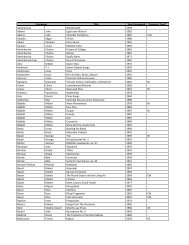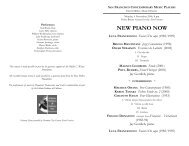From the Top - San Francisco Contemporary Music Players
From the Top - San Francisco Contemporary Music Players
From the Top - San Francisco Contemporary Music Players
You also want an ePaper? Increase the reach of your titles
YUMPU automatically turns print PDFs into web optimized ePapers that Google loves.
Luening, Jack Beeson, and Vladimir Ussachevksy while an undergraduate<br />
at Columbia University, he considers himself mostly self-taught.<br />
Steinberg recalls that even in Wuorinen’s early years, “He never sounded<br />
like an imitator of Stravinsky or Varèse or anyone else.” Like Aaron<br />
Copland more than three decades earlier, Wuorinen came to prominence<br />
with a magisterial set of Piano Variations (1963), bristling with rhythmically<br />
intricate outbursts. Already an accomplished pianist, he premiered<br />
<strong>the</strong> work at one of <strong>the</strong> fi rst concerts of <strong>the</strong> pioneering Group for <strong>Contemporary</strong><br />
<strong>Music</strong>, which he co-founded with composer Harvey Sollberger.<br />
Th e very next year, he was invited to join <strong>the</strong> faculty at Columbia,<br />
and <strong>the</strong> Group remained in residence <strong>the</strong>re until 1971. (Th e Group is<br />
still active in New York City, and Wuorinen moved on to academic appointments<br />
at <strong>the</strong> Manhattan School of <strong>Music</strong> and Rutgers University.)<br />
During <strong>the</strong> late 1960s, Wuorinen was best known for his innovative<br />
ideas about extending Schoenberg’s serial system to musical parameters<br />
o<strong>the</strong>r than pitch–particularly for his ideas about deriving large-scale<br />
structural dimensions (such as <strong>the</strong> length of a composition’s subsections)<br />
from <strong>the</strong> tone row itself. At <strong>the</strong> same time, he was exploring <strong>the</strong><br />
continuum of tone colors and durations made available by electronic<br />
music in Time’s Encomium (1970), for which he won a Pulitzer Prize.<br />
Th ough it remains one of only two electro-acoustic works by Wuorinen,<br />
its subtle distinctions in timbre and rhythm can also be heard in most of<br />
his works for traditional instruments, especially in <strong>the</strong> Percussion Symphony<br />
of 1976 and <strong>the</strong> Percussion Quartet (1994), performed by <strong>the</strong> <strong>San</strong><br />
<strong>Francisco</strong> <strong>Contemporary</strong> <strong>Music</strong> <strong>Players</strong> in 2006.<br />
Th e Percussion Symphony also exemplifi es a preoccupation less frequently<br />
remarked upon in writings about <strong>the</strong> composer: his allusions to musical<br />
styles of <strong>the</strong> past. In this case, two free arrangements of Renaissance<br />
music (Guillaume Dufay’s “Vergine Bella”) serve as interludes between<br />
<strong>the</strong> work’s three movements. Although <strong>the</strong>se transcriptions off er an<br />
audibly “archaic” sound, many of Wuorinen’s later works build more<br />
seamlessly on material from past sources. Th is is especially true of <strong>the</strong><br />
works he wrote during his years in <strong>San</strong> <strong>Francisco</strong>. <strong>From</strong> 1985 until<br />
1989, he directed <strong>the</strong> concert series New and Unusual <strong>Music</strong> and was<br />
composer-in-residence with <strong>the</strong> <strong>San</strong> <strong>Francisco</strong> Symphony, for whom he<br />
wrote both <strong>the</strong> Rhapsody for Violin and Orchestra (1983) and Th e Golden<br />
Dance (1986). Commissioned in celebration of <strong>the</strong> orchestra’s 75th anniversary<br />
and dedicated to its conductor Herbert Blomstedt, <strong>the</strong> latter<br />
work evokes both California’s status as <strong>the</strong> “golden state” as well as <strong>the</strong><br />
SAN FRANCISCO CONTEMPORARY MUSIC PLAYERS<br />
12<br />
so-called “golden mean” of Greek geometry, yet its musical inspiration<br />
lies elsewhere still, building on a twelve-tone row derived from <strong>the</strong> Gregorian<br />
chant melody “Pange lingua.”<br />
Wuorinen recognizes a relationship between his active promotion of<br />
new music and his interest in older compositional styles: “I have felt for<br />
many years that <strong>the</strong> recovery of pre-Classic music and <strong>the</strong> persistence<br />
into our own age of 18th- and 19th-century music...has invalidated<br />
conservative/progressive dichotomies and rendered notions of avant- and<br />
arrière-garde irrelevant. We have most of <strong>the</strong> past with us in <strong>the</strong> living<br />
form, for comfort, infl uence, rejection, embrace.” Instead of adopting a<br />
facile vision of “progress,” Wuorinen aspires to timelessness.<br />
Wuorinen has received <strong>the</strong> most prestigious awards <strong>the</strong> music world<br />
has to off er, including a MacArthur Foundation Fellowship and two<br />
Guggenheim Fellowships. He was elected to <strong>the</strong> American Academy of<br />
Arts and Letters in 1967, and in 1974 he was honored by a request from<br />
Stravinsky’s widow, Vera, to compose a work based on her husband’s<br />
fi nal sketchbook. Wuorinen lives in his native Manhattan where he<br />
continues to foster and promote a wide range of contemporary music.<br />
Among his later works are settings of poetry by John Ashbery and James<br />
Fenton (1998), and an impressive trilogy based on Dante’s eschatological<br />
writings: Th e Mission of Virgil (1993), Th e Great Procession (1995),<br />
and Th e River of Light (1996).<br />
Wuorinen, Trombone Trio (1985)<br />
for tenor trombone, mallet instruments, and piano<br />
Written in <strong>the</strong> summer of 1985, Wuorinen’s Trombone Trio acquired its<br />
unusual instrumental combination after extensive discussion between<br />
<strong>the</strong> composer and <strong>the</strong> dedicatee of <strong>the</strong> work, trombonist Ronald Borror<br />
of <strong>the</strong> contemporary music ensemble Parnassus. Like many of Wuorinen’s<br />
o<strong>the</strong>r scores, its structure owes something to <strong>the</strong> so-called “Golden<br />
Section” (<strong>the</strong> ma<strong>the</strong>matical ratio approached by successive pairs of<br />
numbers in <strong>the</strong> series 0, 1, 1, 2, 3, 5, 8, 13, 21, etc.). Listeners are more<br />
likely to key into <strong>the</strong> Trio’s relatively clear divisions between sections<br />
that diff er in <strong>the</strong>ir momentum, fi guration, and overall character, from<br />
<strong>the</strong> sustained opening to <strong>the</strong> jubilant frenzy of <strong>the</strong> coda.<br />
Eschewing traditional trombone “tricks,” although <strong>the</strong>re are a few glis-<br />
SAN FRANCISCO CONTEMPORARY MUSIC PLAYERS<br />
13




